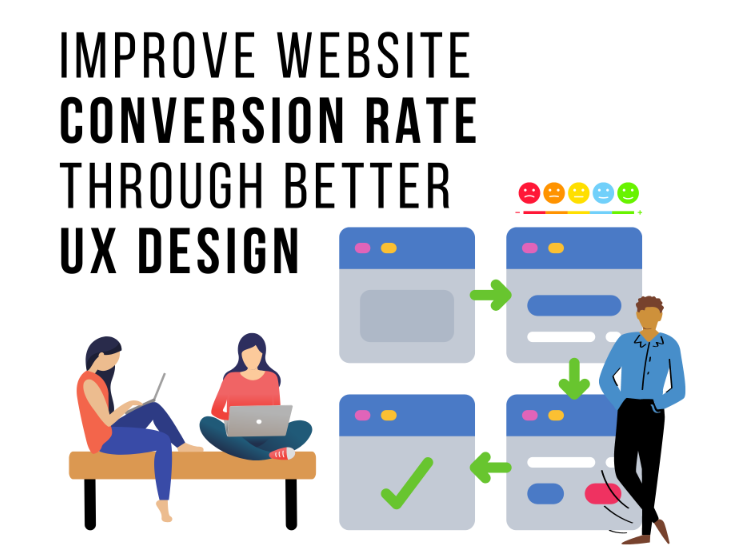User experience (UX) design is an essential element of any website’s success. The quality of UX design can determine whether a user stays on your website or bounces off to a competitor. Not only does UX design impact user engagement, but it can also improve your website’s conversion rate. In this article, we will explore how UX design can improve your website’s conversion rate and provide actionable tips for optimizing your website’s UX design.
What is UX Design?
UX design refers to the process of enhancing user satisfaction by improving the usability, accessibility, and pleasure provided by the interaction between the user and a product. In the context of web design, UX design focuses on improving the user’s experience on a website by optimizing the design, layout, and functionality of the website. The goal of UX design is to create a seamless and enjoyable experience for the user, which leads to increased engagement and conversions.
The Impact of UX Design on Conversion Rate
A website’s conversion rate is the percentage of visitors who complete a desired action, such as making a purchase, filling out a form, or subscribing to a newsletter. The conversion rate is a critical metric for measuring the success of a website. A high conversion rate indicates that users are finding the website useful, engaging, and trustworthy.
UX design plays a crucial role in improving a website’s conversion rate. A well-designed website can guide users through the conversion funnel, making it easier for them to complete the desired action. Here are some ways that UX design can impact your website’s conversion rate:
- User Engagement: Engaging the user through an intuitive and visually appealing design can help keep them on the website for longer periods, increasing the chances of a conversion.
- Usability: A website that is easy to navigate and understand can help the user find what they are looking for quickly, making it more likely for them to convert.
- Trustworthiness: A website that looks professional and trustworthy can instill confidence in the user, making them more likely to complete the desired action.
- Mobile Optimization: With the increasing use of mobile devices, it is essential to optimize the website’s design for mobile users. A mobile-friendly website can improve the user experience and increase the conversion rate.
Tips for Optimizing UX Design for Conversion Rate
Now that we understand the importance of UX design for improving a website’s conversion rate, let’s explore some actionable tips for optimizing UX design.
- Simplify Navigation: A clear and simple navigation menu can make it easier for users to find what they are looking for and reduce bounce rates.
- Optimize Page Load Speed: A slow-loading website can lead to frustration and increased bounce rates. Optimizing page load speed can improve the user experience and increase the conversion rate.
- Use Visual Hierarchy: A well-designed website should have a clear visual hierarchy, with important elements such as calls-to-action (CTAs) and forms given priority.
- Ensure Mobile Optimization: A mobile-friendly website is essential for providing a seamless experience to mobile users. Ensure that the website is optimized for mobile devices, with responsive design and fast load times.
- Use A/B Testing: A/B testing is a powerful tool for optimizing UX design for conversion rate. By testing different design elements, such as color schemes and CTAs, you can identify.
- Use A/B Testing: A/B testing is a powerful tool for optimizing UX design for conversion rate. By testing different design elements, such as color schemes and CTAs, you can identify which design is most effective in converting users.
- Utilize White Space: White space, also known as negative space, is the empty space around design elements. Proper use of white space can make the website feel more spacious and easier to navigate, improving the user experience and conversion rate.
- Provide Clear CTAs: Calls-to-action (CTAs) are essential for guiding the user towards completing a desired action. CTAs should be clear, prominent, and placed in strategic locations throughout the website.
- Ensure Consistency: Consistency is key to a well-designed website. The website’s design, layout, and color scheme should be consistent throughout, creating a cohesive and professional look.
- Use High-Quality Images: High-quality images can enhance the user experience and make the website feel more trustworthy and professional.
- Use Responsive Design: Responsive design ensures that the website looks and functions well on all devices, including desktops, tablets, and mobile phones. A responsive website can improve the user experience and conversion rate across all devices.
Conclusion
In conclusion, UX design plays a crucial role in improving a website’s conversion rate. By optimizing the design, layout, and functionality of the website, you can create a seamless and enjoyable experience for the user, increasing engagement and conversions. Follow the tips provided in this article to optimize your website’s UX design and improve your conversion rate.
A1. Conversion rate is the percentage of website visitors who complete a desired action, such as making a purchase, filling out a form, or subscribing to a newsletter.
A2. UX design can impact conversion rate by improving user engagement, usability, trustworthiness, and mobile optimization.
A3. A/B testing is a method of comparing two versions of a webpage or app against each other to determine which one performs better.
A4. Responsive design is an approach to web design that ensures a website looks and functions well on all devices, including desktops, tablets, and mobile phones.
A5. Consistency is important in UX design because it creates a cohesive and professional look, enhances usability, and improves user trust in the website.
A6. To improve your website’s usability, you can simplify navigation, use clear and concise language, ensure fast page load times, and provide easy-to-use forms and CTAs.
A7. High-quality images can enhance the user experience, create a professional and trustworthy look, and improve engagement and conversion rates.
A8. You can measure your website’s conversion rate by setting up conversion tracking through tools such as Google Analytics, which can track actions such as purchases, form submissions, and clicks on CTAs.
A9. Common UX design mistakes to avoid include cluttered and confusing layouts, unclear navigation, slow page load times, and lack of mobile optimization.
A10. The frequency of updating your website’s UX design depends on your business needs and goals, but it’s generally a good idea to review and update your design regularly to ensure it remains current, functional, and effective in driving conversions.
Remember, optimizing your website’s UX design is an ongoing process that requires constant attention and improvement. By prioritizing the user experience and implementing best practices, you can create a website that not only looks great but also converts visitors into customers.




